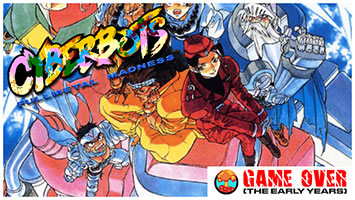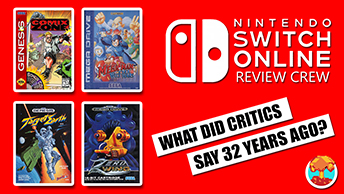- CLASSIC MAGAZINES
- REVIEW CREW
A show recapping what critics thought back
when classic games first came out! - NEXT GENERATION'S BEST & WORST
From the worst 1-star reviews to the best
5-stars can offer, this is Next Generation! - NINTENDO POWER (ARCHIVE)
Experience a variety of shows looking at the
often baffling history of Nintendo Power! - MAGAZINE RETROSPECTIVE
We're looking at the absolutely true history of
some of the most iconic game magazines ever! - SUPER PLAY'S TOP 600
The longest and most ambitious Super NES
countdown on the internet! - THEY SAID WHAT?
Debunking predictions and gossip found
in classic video game magazines! - NEXT GENERATION UNCOVERED
Cyril is back in this spin-off series, featuring the
cover critic review the art of Next Generation! - HARDCORE GAMER MAGAZING (PDF ISSUES)
Download all 36 issues of Hardcore Gamer
Magazine and relive the fun in PDF form!
- REVIEW CREW
- ELECTRONIC GAMING MONTHLY
- ELECTRONIC GAMING MONTHLY RANKS
From Mario to Sonic to Street Fighter, EGM
ranks classic game franchises and consoles! - ELECTRONIC GAMING MONTHLY BEST & WORST
Counting down EGM’s best and worst reviews
going year by year, from 1989 – 2009! - ELECTRONIC GAMING BEST & WORST AWARDS
11-part video series chronicling the ups and
downs of EGM’s Best & Worst Awards!
- ELECTRONIC GAMING MONTHLY RANKS
- GAME HISTORY
- GAME OVER: STORY BREAKDOWNS
Long-running series breaking down game
stories and analyzing their endings! - A BRIEF HISTORY OF GAMING w/ [NAME HERE]
Real history presented in a fun and pithy
format from a variety of game historians! - THE BLACK SHEEP
A series looking back at the black sheep
entries in popular game franchises! - INSTANT EXPERT
Everything you could possibly want to know
about a wide variety of gaming topics! - FREEZE FRAME
When something familiar happens in the games
industry, we're there to take a picture! - I'VE GOT YOUR NUMBER
Learn real video game history through a series
of number-themed episodes, starting at zero! - GREAT MOMENTS IN BAD ACTING
A joyous celebration of some of gaming's
absolute worst voice acting!
- GAME OVER: STORY BREAKDOWNS
- POPULAR SHOWS
- DG NEWS w/ LORNE RISELEY
Newsman Lorne Riseley hosts a regular
series looking at the hottest gaming news! - REVIEW REWIND
Cyril replays a game he reviewed 10+ years
ago to see if he got it right or wrong! - ON-RUNNING FEUDS
Defunct Games' longest-running show, with
editorials, observations and other fun oddities! - DEFUNCT GAMES QUIZ (ARCHIVE)
From online quizzes to game shows, we're
putting your video game knowledge to the test!- QUIZ: ONLINE PASS
Take a weekly quiz to see how well you know
the news and current gaming events! - QUIZ: KNOW THE GAME
One-on-one quiz show where contestants
find out if they actually know classic games! - QUIZ: THE LEADERBOARD
Can you guess the game based on the classic
review? Find out with The Leaderboard!
- QUIZ: ONLINE PASS
- DEFUNCT GAMES VS.
Cyril and the Defunct Games staff isn't afraid
to choose their favorite games and more! - CYRIL READS WORLDS OF POWER
Defunct Games recreates classic game
novelizations through the audio book format!
- DG NEWS w/ LORNE RISELEY
- COMEDY
- GAME EXPECTANCY
How long will your favorite hero live? We crunch
the numbers in this series about dying! - VIDEO GAME ADVICE
Famous game characters answer real personal
advice questions with a humorous slant! - FAKE GAMES: GUERILLA SCRAPBOOK
A long-running series about fake games and
the people who love them (covers included)! - WORST GAME EVER
A contest that attempts to create the worst
video game ever made, complete with covers! - LEVEL 1 STORIES
Literature based on the first stages of some
of your favorite classic video games! - THE COVER CRITIC
One of Defunct Games' earliest shows, Cover
Critic digs up some of the worst box art ever! - COMMERCIAL BREAK
Take a trip through some of the best and
worst video game advertisements of all time! - COMIC BOOK MODS
You've never seen comics like this before.
A curious mix of rewritten video game comics!
- GAME EXPECTANCY
- SERIES ARCHIVE
- NINTENDO SWITCH ONLINE ARCHIVE
A regularly-updated list of every Nintendo
Switch Online release, plus links to review! - PLAYSTATION PLUS CLASSIC ARCHIVE
A comprehensive list of every PlayStation
Plus classic release, including links! - RETRO-BIT PUBLISHING ARCHIVE
A regularly-updated list of every Retro-Bit
game released! - REVIEW MARATHONS w/ ADAM WALLACE
Join critic Adam Wallace as he takes us on a
classic review marathon with different themes!- DEFUNCT GAMES GOLF CLUB
Adam Wallace takes to the links to slice his way
through 72 classic golf game reviews! - 007 IN PIXELS
Adam Wallace takes on the world's greatest spy
as he reviews 15 weeks of James Bond games! - A SALUTE TO VAMPIRES
Adam Wallace is sinking his teeth into a series
covering Castlevania, BloodRayne and more! - CAPCOM'S CURSE
Adam Wallace is celebrating 13 days of Halloween
with a line-up of Capcom's scariest games! - THE FALL OF SUPERMAN
Adam Wallace is a man of steel for playing
some of the absolute worst Superman games! - THE 31 GAMES OF HALLOWEEN
Adam Wallace spends every day of October afraid
as he reviews some of the scariest games ever! - 12 WEEKS OF STAR TREK
Adam Wallace boldly goes where no critic has
gone before in this Star Trek marathon!
- DEFUNCT GAMES GOLF CLUB
- DAYS OF CHRISTMAS (ARCHIVE)
Annual holiday series with themed-episodes
that date all the way back to 2001!- 2015: 30 Ridiculous Retro Rumors
- 2014: 29 Magazines of Christmas
- 2013: 29 Questionable Power-Ups of Christmas
- 2012: 34 Theme Songs of Christmas
- 2011: 32 Game Endings of Christmas
- 2010: 31 Bonus Levels of Christmas
- 2009: 30 Genres of Christmas
- 2008: 29 Controls of Christmas
- 2007: 34 Cliches of Christmas
- 2006: 33 Consoles of Christmas
- 2005: 32 Articles of Christmas
- 2004: 31 Websites of Christmas
- 2003: 29 Issues of Christmas
- 2002: 28 Years of Christmas
- 2001: 33 Days of Christmas
- NINTENDO SWITCH ONLINE ARCHIVE
- REVIEW ARCHIVE
- FULL ARCHIVE
The Rewritable History of Game Storage

Thank god we don't have to put up with Nintendo, Sony and Microsoft running attack ads!
Even before they were commercially released, video games existed. They were designed for specific computers (the kind that took up entire rooms) by experimenting programmers. There is much debate over what the first game was, but the storage medium was the same for all
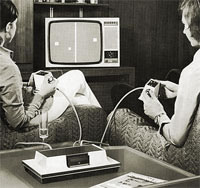
These classic black and white games always look more fun in the pictures!
Of course, these were only ever used by people who had regular access to the computers (mostly technicians who didn't need to book time on the machines). The first access most people had to video games was the aforementioned Magnavox Odyssey. The games for this system were "stored" in encased circuit boards, all of which were included with the system. These boards contained pathways that linked the circuits within the console, thus forming the
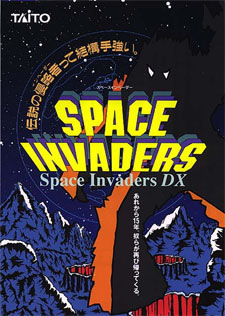
Not every game is worth accessing a special computer to play!
The next generation of cartridges brought software into the equation. Containing ROM with pre-written software, this type of cartridge has been used in classic computers, modular arcade machines, portable devices and all early consoles since the Atari 2600. These cartridges can also contain special chips to grant additional functionality. This flexibility led to some significant advances in gaming. For
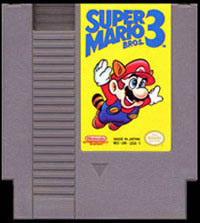
Nintendo didn't just make amazing games in the 1980s, they also revolutionized the entire cartridge format!
The Super Nintendo was designed specially to function with graphics chips built into the cartridges. The SNES hardware was 2D, but these special chips could create full 3D objects. The most famous example of this is the 1993 space shooter game, Star Fox. Even though cartridges have now been phased out in favor of disc-based media, these early applications of the cartridge's unique features drastically altered early game development.
While the cartridge was favored by the console crowd, early computers used other storage methods as well, both of which are icons of classic computing. The first of these is the audio cassette. These

The famicom cartridges are good for a lot of things (taking a bullet, as a throw toy, etc.), but they aren't a good substitute for real water!
The other classic PC storage device is the 5 1/4 inch floppy disk of "Blue Monday" fame. These were fast, reliable and had plenty of room (at least for 1975) but they were also fairly expensive early on, especially the disk drives themselves. It is notable that the Famicom (the Japanese
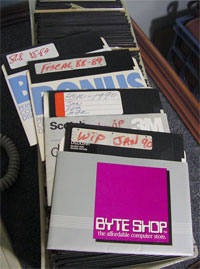
Unlike the famicom cartridges, these floppy discs can't take a bullet!
Software storage in computers and consoles converged with the rise of the compact disc. CDs have massive storage capabilities and are cheap to produce, making them perfect for games that were increasing in size. There were a series of disc drive console add-ons released in the late 80s and early 90s, including one for the Sega Genesis, TurboGrafx-16 and Atari Jaguar. Not to be outdone by industry players like Sega and Atari, Nintendo announced a CD-ROM add-on for their 16-bit Super NES. Unfortunately this device was never released by Nintendo and would become one of the long list of peripherals and add-ons that didn't make it out of R&D. This
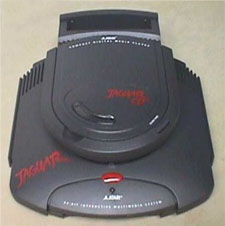
I'm not going to say that the Atari Jaguar was a good looking system without the CD add-on, but at least it didn't look like a toilet!
The next generation of consoles was made up entirely of disc-based systems, (storing saved games on memory cards or internal storage) with the exception of the Nintendo 64. Continued reliance on now comparatively expensive and small capacity cartridges has been cited as a key reason for Nintendo's backseat position at the end of that console cycle, though it

The Nintendo DS is just about the only console not using some sort of disc-based media, perhaps that's why these cool kids like it so much!
While discs will certainly be the standard for large games for the foreseeable future, the internet is the place to turn for smaller titles. The Xbox Live Arcade is a hugely successful game download service and original Xbox games (often clocking in at 3 GB) have recently been made available for download. Sony has notably released major first-party titles like "Warhawk" in both disc and downloadable forms, and the PC services that allow full game downloads (such as Steam) have
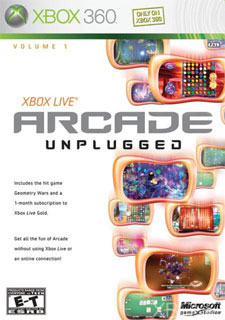
While you can download all of the Xbox Live Arcade games to your hard drive, Microsoft decided it would be a good idea to sell a compliation disc, too!
While these game formats have been instrumental in the development of video games, there have been some far less successful standards proposed. The Sega Master System is particularly notable in this regard. It included a slot for games on cards which were cheaper to manufacture, alongside the standard cartridge slot. It was also the first game console that could function without a game inserted, as it contained a game known simply as "Snail Maze" that would run if there was no cartridge or card present. The TurboGrafx-16 also featured a similar card slot for their unique HuCard games.
There have also been attempts to update the original audio cassette standard by using VHS cassettes. These

If I were the princess I would run as far away as possible, Dirk only seems to bring pain and trouble!
Precursor to the DVD, a few arcade games used laserdiscs to play high quality video. These include the infamous "Dragon's Lair" and "Space Ace". These games were barely playable, but have maintained a cult following for their impressive cartoon animations (done by famous cartoonist Don Bluth) and cheesy production values. Aside from being not very much fun to play, the units would frequently break, as the discs could easily be knocked out of alignment.
The most successful of these fringe formats is Nintendo's E-Reader device for the GBA. This device reads cards; it's basically
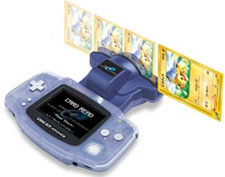
It's not the prettiest add-on and it isn't very practical, but the E-Reader managed to gain a certain amount of success!
While the low cost of discs has provided us with nigh unlimited storage capacity, the evolution of other storage mediums has certainly contributed significantly, both to the face and the core of video gaming. Cartridges, tapes and floppies still hold a special place in the hearts of many gamers, and the creativity of the hardware designers that devised these formats certainly deserves a place of honor in video game history and culture.





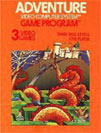
HOME |
CONTACT |
NOW HIRING |
WHAT IS DEFUNCT GAMES? |
NINTENDO SWITCH ONLINE |
RETRO-BIT PUBLISHING
Retro-Bit |
Switch Planet |
The Halcyon Show |
Same Name, Different Game |
Dragnix |
Press the Buttons
Game Zone Online | Hardcore Gamer | The Dreamcast Junkyard | Video Game Blogger
Dr Strife | Games For Lunch | Mondo Cool Cast | Boxed Pixels | Sega CD Universe | Gaming Trend
Game Zone Online | Hardcore Gamer | The Dreamcast Junkyard | Video Game Blogger
Dr Strife | Games For Lunch | Mondo Cool Cast | Boxed Pixels | Sega CD Universe | Gaming Trend
Copyright © 2001-2025 Defunct Games
All rights reserved. All trademarks are properties of their respective owners.
All rights reserved. All trademarks are properties of their respective owners.














